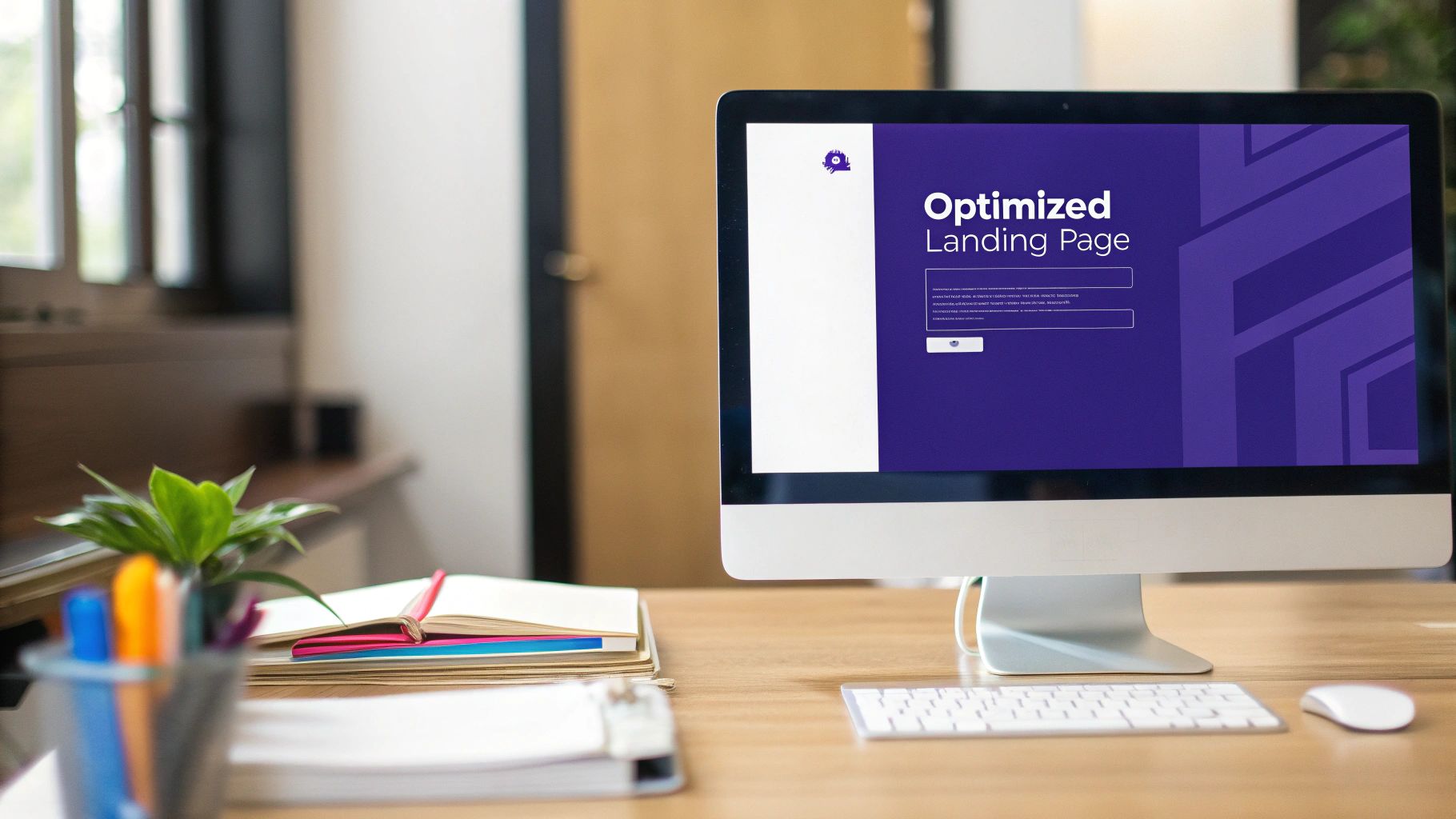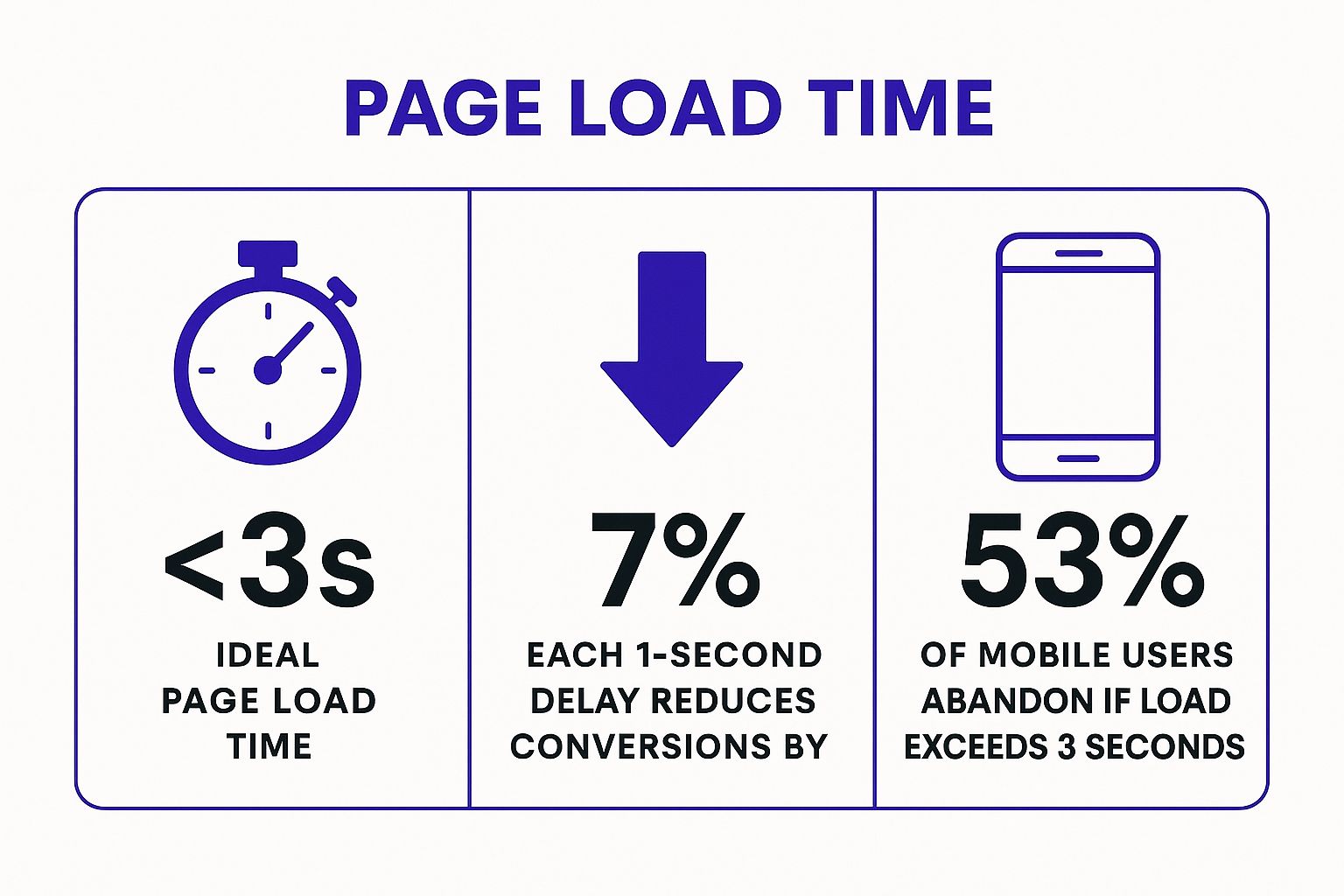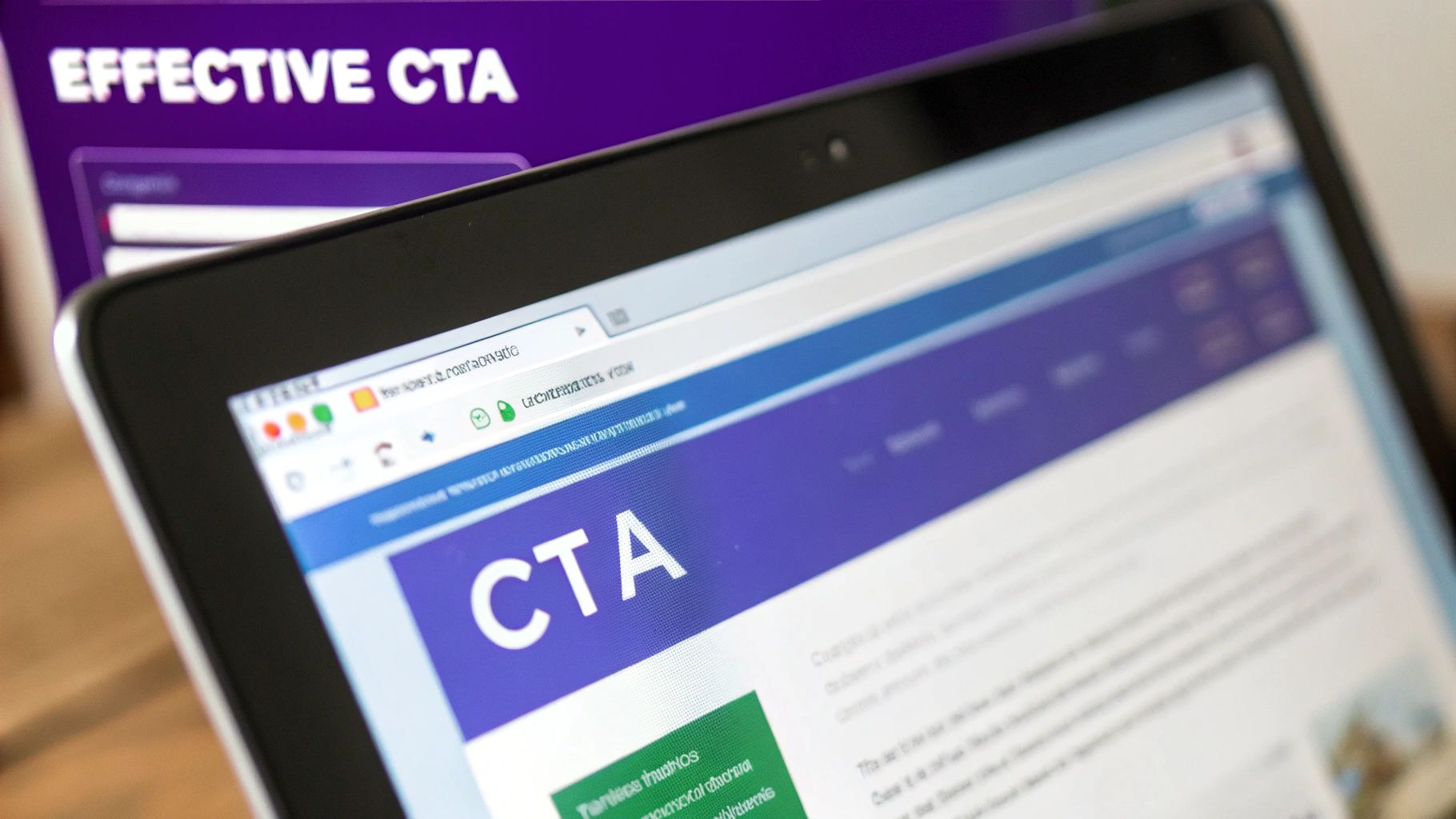In today's competitive digital marketplace, attracting traffic to your website is only half the battle. The real challenge, and where significant growth lies, is in converting those visitors into loyal customers, subscribers, or qualified leads. This is the core function of Conversion Rate Optimization (CRO), the systematic process of increasing the percentage of visitors who take a desired action. Executing effective conversion rate optimization strategies isn't just a minor tweak; it's a fundamental business lever that directly impacts revenue, enhances user experience, and maximizes your marketing return on investment.
This article moves beyond generic advice to provide a comprehensive roundup of 10 powerful, data-driven strategies designed to transform your website's performance. We will dive into actionable tactics, from foundational A/B testing and landing page optimization to more advanced personalization and exit-intent technologies. Each point is structured to give you a clear roadmap for refining your sales funnel, improving lead engagement, and boosting your bottom line. For a comprehensive understanding of the field, delving into 10 conversion optimization best practices can provide a strong framework for your strategy.
Whether your goal is to reduce cart abandonment, increase demo requests, or simply streamline your entire sales process, this guide provides the battle-tested insights you need. You will learn not just what to do, but how to implement these changes effectively to see measurable results. Prepare to unlock the true potential of your existing traffic and turn your website into a highly efficient conversion machine.
A/B testing, also known as split testing, is a foundational conversion rate optimization strategy that removes guesswork from your decision-making. The methodology involves a controlled experiment where two versions of a single element (Version A, the control, and Version B, the variation) are shown to different segments of your audience simultaneously. By measuring which version achieves a higher conversion rate, you can implement the winner with confidence, knowing it's backed by real user data.
This approach is indispensable when you want to make incremental improvements to high-impact pages. It allows you to scientifically validate changes to headlines, calls-to-action (CTAs), images, form fields, and even entire page layouts. The 2008 Obama campaign famously used A/B testing to optimize its donation page, ultimately raising an additional $60 million by finding the best combination of media and button text.
To run a successful A/B test, it's crucial to follow a structured process. This ensures your results are reliable and your insights are clear.
Key Insight: A/B testing transforms optimization from a game of opinions into a data-driven science. Every test, whether it wins or loses, provides valuable insight into your audience's preferences and behaviors.
Landing page optimization is the process of creating and refining dedicated web pages designed for a single conversion goal. Instead of sending traffic from ads or email campaigns to a generic homepage, visitors "land" on a focused page that removes distractions and guides them toward one specific action. This singular focus makes it a powerful conversion rate optimization strategy for maximizing the ROI of paid and organic marketing efforts.

This approach is essential for any campaign with a clear call-to-action, such as signing up for a webinar, downloading an ebook, or requesting a demo. By aligning the message from the ad to the page and eliminating competing links or navigation, you create a seamless user journey. Dropbox famously simplified its landing page to focus on a single CTA, leading to a significant increase in signups. Similarly, Unbounce, a platform built around this concept, increased its own conversions by 41% through iterative landing page optimization.
To build high-converting landing pages, you must be intentional about every element on the page. A structured approach ensures your design and copy work together to persuade visitors.
Key Insight: A landing page is not just another page on your website; it's a focused conversion machine. By stripping away distractions and aligning every element with a single objective, you create the most direct path from click to conversion.
Personalization is a powerful conversion rate optimization strategy that moves beyond a one-size-fits-all approach. It involves tailoring website content, messaging, and the overall user experience to individual visitors based on their data, such as behavior, location, or past interactions. Dynamic content is the mechanism that makes this possible, automatically adjusting what a user sees to create a more relevant and engaging journey.
This strategy is crucial for cutting through the noise and making users feel understood. Instead of showing generic offers, you can present content that directly addresses a visitor's needs or interests at that exact moment. Amazon’s recommendation engine, which is responsible for a significant portion of its revenue, is a prime example of personalization at scale. By suggesting products based on browsing history and purchase data, Amazon creates a hyper-relevant shopping experience that drives sales.
Successfully implementing personalization requires a strategic approach that leverages user data responsibly and effectively. This ensures a better user experience without being intrusive.
Key Insight: Personalization transforms a monologue into a dialogue. By listening to user data and responding with relevant content, you build a stronger connection that naturally guides visitors toward conversion.
Social proof is a psychological phenomenon where people assume the actions of others reflect correct behavior for a given situation. As a conversion rate optimization strategy, it involves showcasing positive feedback and external validation to build credibility and reduce visitor anxiety. By displaying testimonials, reviews, customer logos, and security badges, you signal that your offering is trusted and valued by others, making new visitors feel more confident in their decision to convert.
This approach is highly effective because it taps into our innate desire for social validation. When a potential customer sees that reputable companies or a large number of peers are already using your service, it alleviates their perceived risk. For instance, SaaS company Slack prominently displays the logos of well-known clients like Airbnb and Target, instantly borrowing credibility. Similarly, Booking.com uses real-time notifications like “Booked 5 times in the last 24 hours” to create a sense of popular demand.

To leverage social proof, you must integrate it authentically and strategically across your user journey. The goal is to build trust at key decision-making moments without overwhelming the visitor.
Key Insight: Social proof is not just about showing off; it's about reducing friction and building confidence. By demonstrating that others trust you, you make it easier for new customers to do the same, directly impacting your conversion rates.
Optimizing forms and the checkout process is a high-impact conversion rate optimization strategy focused on removing friction at the most critical stage of the user journey. The core principle is that every additional field, step, or moment of confusion increases cognitive load and the likelihood of abandonment. By streamlining these final interactions, you make it as easy as possible for motivated users to complete a purchase, sign up, or submit an inquiry, directly boosting your conversion rates.
This approach is crucial because it targets users who have already shown high intent. For example, Expedia famously increased annual profit by $12 million simply by removing one optional "Company name" field from their booking form, which was confusing users. Similarly, Amazon’s patented 1-Click ordering system revolutionized e-commerce by reducing the checkout process to a single interaction, demonstrating the immense value of a frictionless path to purchase.
A successful optimization effort requires a user-centric approach that systematically eliminates barriers. The goal is to make the process feel effortless and intuitive.
autocomplete="email") to let browsers assist users.Key Insight: The final steps of conversion are the most fragile. Simplifying forms and checkouts isn't just about convenience; it's about respecting the user's time and momentum, directly translating their intent into a completed action.
Page speed optimization is a critical technical strategy that directly impacts user experience and conversion rates. It involves reducing the time it takes for a web page to load by enhancing server performance, compressing files, and optimizing code. In a digital environment where users expect instant results, even a one-second delay can cause visitors to abandon your site, leading to lost revenue and increased bounce rates.
This strategy is fundamental because a slow website creates friction before a user even engages with your content or products. Major companies have quantified the immense cost of slow performance. For example, Amazon found that a 100-millisecond delay costs them 1% in sales, and Walmart saw a 2% conversion increase for every one-second improvement in load time. These figures prove that speed is not just a feature; it's a prerequisite for success.
The infographic below highlights just how crucial fast loading times are for retaining users and driving conversions.

The data clearly illustrates that the three-second mark is a critical threshold where user patience drops off dramatically, especially on mobile devices.
Improving your site's performance requires a systematic approach to identifying and fixing bottlenecks. The goal is to make your site feel instantaneous to every user.
Key Insight: Page speed is the first impression your website makes. Optimizing it is one of the most powerful conversion rate optimization strategies because it removes a universal point of friction and demonstrates respect for your user's time.
A clear value proposition is the cornerstone of high-converting pages. It’s a concise statement that instantly communicates why a customer should choose your product over a competitor's. It articulates the unique benefit you deliver, the problem you solve, and what makes you the best choice. If visitors land on your page and can't answer "What's in it for me?" within seconds, they will leave, making this one of the most critical conversion rate optimization strategies to master.
This approach is essential because it forms the visitor's first impression and sets the stage for their entire journey. A powerful value proposition aligns your offer directly with the visitor's needs, reducing friction and building immediate trust. For example, Crazy Egg significantly boosted conversions by shifting its messaging from feature-focused descriptions to a value proposition that directly addressed specific customer pain points, making the benefit instantly clear and relatable.
Crafting and refining your value proposition is an ongoing process that requires clarity, empathy, and testing. It should be the most prominent message on any key landing page.
Key Insight: Your value proposition isn't just a marketing slogan; it's a fundamental promise to your customer. It should be the clearest, most compelling answer to the silent question every visitor has: "Why should I choose you?"
As the final gateway to conversion, your call-to-action (CTA) is arguably the most important element on any given page. Strategic CTA optimization is one of the most impactful conversion rate optimization strategies, focusing on the design, copy, and placement of buttons and links to guide users toward a desired action. It transforms the CTA from a simple button into a persuasive, action-oriented trigger.

This process involves a detailed analysis of everything from button color and size to the specific words used in the copy. Since the CTA is the direct link to a sale, signup, or download, even minor tweaks can lead to significant gains. For example, Performable famously increased conversions by 21% simply by changing its button text from the generic "Request a Demo" to the value-driven "Get a Free Marketing Analysis," directly addressing user intent.
Effective CTA optimization requires a blend of psychological principles, design best practices, and rigorous testing. Follow these steps to create CTAs that convert.
Key Insight: A high-converting CTA doesn't just ask for a click; it communicates value and answers the user's silent question: "What's in it for me?" Frame your CTA copy around the benefit the user will receive.
With mobile devices now driving the majority of global web traffic, mobile optimization is no longer a choice but a critical component of any successful conversion rate optimization strategy. This approach ensures your website not only displays correctly but also functions flawlessly and intuitively on smartphones and tablets. It goes beyond simple responsive design to encompass mobile-specific user experience (UX) elements like faster load times, thumb-friendly navigation, and streamlined checkout processes.
This strategy is indispensable for capturing a massive and growing segment of your audience. Companies that prioritize a mobile-first experience see significant returns. For instance, clothing retailer O'Neill increased its mobile revenue by over 101% after a focused mobile optimization effort, while Target improved its mobile conversion rate by simplifying its checkout process specifically for small screens. These examples highlight the immense revenue potential unlocked by a superior mobile experience.
A truly effective mobile experience requires a dedicated and thoughtful approach. It’s about adapting your entire user journey to the context of a smaller screen and on-the-go usage.
type="tel" for phone numbers) to activate the correct on-screen keyboard.Key Insight: Mobile optimization isn't just about making your site fit on a smaller screen; it's about re-imagining the user experience to meet the specific needs and expectations of a mobile audience. A seamless mobile journey directly translates to higher conversions.
Exit-intent technology is a powerful conversion rate optimization strategy that gives you a final opportunity to engage visitors before they leave your site. It works by tracking a user's mouse movements and velocity, detecting when they are about to navigate away or close the tab. This action triggers a targeted popup, overlay, or message designed to recapture their attention and persuade them to stay or complete an action.
This strategy is highly effective because it targets users at a critical moment of indecision or abandonment. When combined with retargeting, which serves targeted ads to previous site visitors across the web, you create a comprehensive system for re-engaging users who didn't convert on their first visit. For example, Outerknown successfully reduced cart abandonment by triggering a free shipping offer to users showing exit intent from their checkout page.
To maximize the impact of exit-intent popups without frustrating users, a strategic approach is essential. A well-timed, valuable offer can turn a lost visitor into a lead or customer.
Key Insight: Exit-intent technology isn't about blocking the exit; it's about providing a compelling reason to stay. A timely, valuable offer can transform an abandoning visitor into a lifelong customer.
The journey through the world of conversion rate optimization strategies is not about finding a single magic bullet. Instead, it's about building a systematic, data-driven engine for continuous improvement. We've explored ten powerful pillars, from the foundational precision of A/B testing and the critical first impression of landing page optimization to the sophisticated relationship-building power of personalization and dynamic content. Each strategy represents a unique lever you can pull to enhance user experience and drive desired actions.
Remember, the goal is not merely to implement these tactics but to cultivate a culture of curiosity and experimentation. True optimization mastery comes from understanding the why behind user behavior, not just the what. This means digging into analytics, listening to customer feedback, and consistently challenging your assumptions. The strategies discussed here are your toolkit for turning those invaluable insights into measurable impact.
As you move forward, avoid the temptation to tackle everything at once. A successful CRO program is built on focus and iteration. Start by identifying the most significant points of friction in your user journey. Is it a high cart abandonment rate? A low form submission percentage? A confusing value proposition? Use this as your starting point.
Here’s a practical framework to get started:
It’s crucial to recognize that CRO is a long-term commitment, not a one-time fix. A 1% improvement might seem small, but when you consistently achieve these small wins across multiple touchpoints, the effects compound dramatically. Improving your form conversion rate by 2%, your CTA click-through rate by 3%, and your page speed to reduce bounce rate by 5% creates a powerful multiplier effect on your overall revenue and customer lifetime value.
This persistent, iterative approach separates market leaders from the competition. It transforms your website from a static digital brochure into a dynamic, intelligent system that constantly adapts to better serve your customers. By embracing this mindset, you are not just boosting numbers; you are building a more resilient, customer-centric business that is prepared for sustainable growth. The fusion of these proven conversion rate optimization strategies with a commitment to ongoing testing is your ultimate path from insight to impact.
Ready to amplify your CRO efforts with intelligent automation? Many of the strategies discussed, like re-engaging hesitant leads or personalizing outreach, can be supercharged with AI. Discover how Upcraft's conversational AI can automate lead engagement, follow-up, and re-engagement, ensuring you convert more leads with less manual effort. Visit Upcraft to see how you can put your lead conversion on autopilot.
Enter your contact information and Archer will start a conversation with you via text message.